You may also like:
The 2024 BMW M2 delivers 453 horsepower from its S58 twin-turbo inline-six for an original MSRP of $64,195, but as of September 2025, used examples trade between $47,000-$56,000—offering potential savings of $10,000-$17,000 versus new[1][2]. This second-year G87 generation model carries over from 2023 unchanged but precedes the 2025’s 20-horsepower increase to 473 hp and technology updates. Buyers willing to accept the previous-year model gain proven reliability without first-year production issues while avoiding steepest depreciation, making the 2024 M2 compelling value proposition for performance enthusiasts in today’s market.
According to Autvex automotive experts, the 2024 BMW M2 represents strategic buying opportunity in September 2025. While lacking the 2025’s incremental improvements, the 2024 delivers identical fundamental driving dynamics, manual transmission availability, and weapons-grade performance at significantly reduced pricing through depreciation absorption.
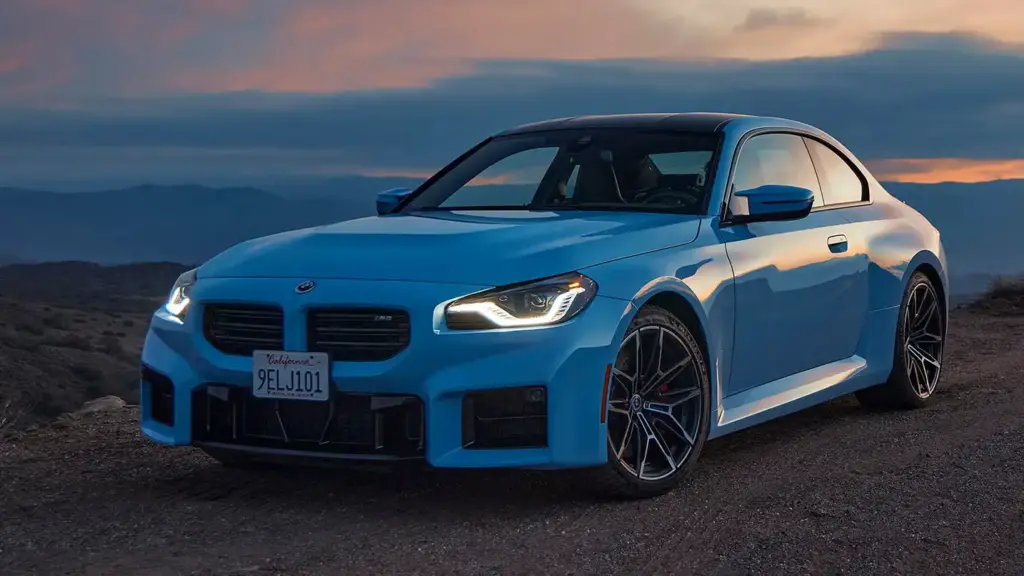
What You Need to Know About the 2024 BMW M2
Overview and Model Year Position
The 2024 M2 occupies unique position as second-year G87 generation model, representing refinement without revolution[1][3].
2024 model year specifications:
- Generation: G87 (second year following 2023 redesign)
- Engine: S58 3.0L twin-turbo inline-six producing 453 hp
- Original MSRP: $63,200 base / $64,195 including $995 destination
- Production changes: Carryover from 2023 with no major updates
- Successor context: Final year before 2025’s 473 hp power increase
- Platform: Shares BMW M3/M4 CLAR architecture and components[1][3]
The G87 generation represented complete redesign from beloved F87 M2, adopting larger M3/M4 platform that added weight but delivered superior handling capability. While styling proved polarizing initially, the expanded track width and aggressive fender flares enabled exceptional cornering grip defining modern M2 character[3].
Why Consider a 2024 Model Now (September 2025)
Strategic timing creates compelling value proposition for 2024 M2 purchases in current market conditions[1][2].
Current market advantages:
- Depreciation absorbed: First-year loss of $17,000-$19,000 (27-30%) already taken by original owner
- Used pricing: $47,000-$56,000 range depending on mileage and condition
- New 2024 inventory: Remaining dealer stock discounted $59,000-$62,000
- Savings versus 2025: $10,000-$15,000 lower than new 2025 MSRP
- Proven reliability: One full production year validates manufacturing quality
- Warranty coverage: Many examples retain significant factory warranty (4yr/50K miles)
- CPO availability: Certified Pre-Owned options extend coverage one additional year[1][2]
A Denver-based enthusiast recently shared his 2024 M2 purchase experience: “I found a 6,500-mile manual example with Carbon Package for $54,900 at local BMW dealer. Original window sticker showed $78,000—I saved $23,000 by waiting 14 months and let someone else absorb depreciation.”
Key Differences: 2024 vs 2025 BMW M2
Understanding model year changes helps buyers assess whether 2025 updates justify premium pricing[4].
| Specification | 2024 M2 | 2025 M2 |
|---|---|---|
| Power output | 453 hp @ 6,250 rpm | 473 hp @ 6,250 rpm |
| Torque | 406 lb-ft | 406 lb-ft (manual) / 442 lb-ft (auto) |
| Infotainment | iDrive 8 | iDrive 8.5 (improved) |
| Steering wheel | Standard flat-bottom | Redesigned with red stripe |
| Color options | Limited palette | Expanded (Sao Paulo Yellow, Vegas Red) |
| M Carbon seats | Package-only ($9,900) | Standalone option available |
| Suspension | Standard M tuning | Reportedly refined (less harsh) |
| Price new | $64,195 | $66,675 (+$2,480) |
The 20-horsepower difference proves negligible in real-world driving—both models achieve sub-4-second 0-60 mph times. The technology gap similarly remains minimal for most buyers, as iDrive 8 provides comprehensive functionality. Buyers prioritizing latest specifications should choose 2025; those maximizing value should target well-maintained 2024 examples[4].
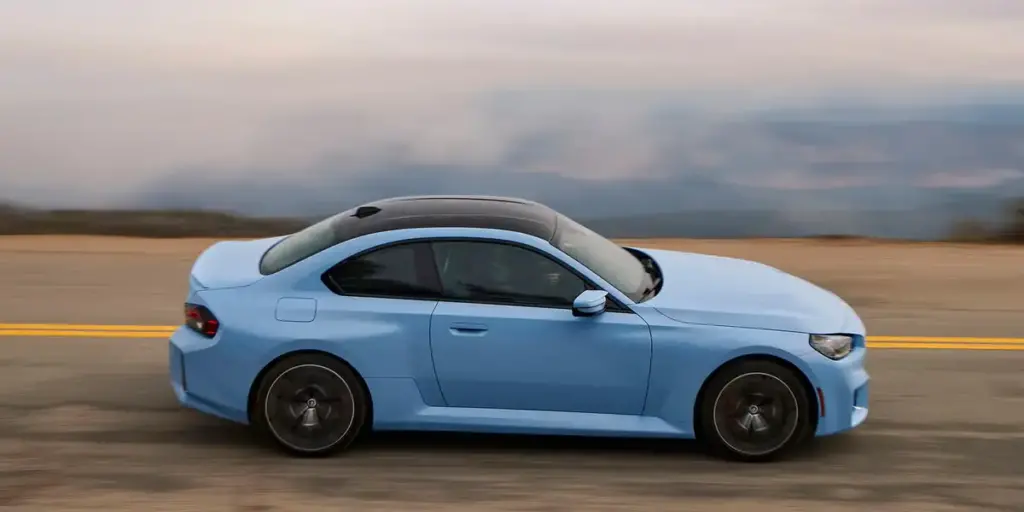
2024 BMW M2 Performance and Engine
S58 Twin-Turbo Inline-Six Engine
The S58 represents BMW’s most advanced inline-six performance engine, sharing architecture with M3/M4 while receiving M2-specific calibration[1][5].
S58 engine specifications:
- Displacement: 3.0 liters (2,993 cc)
- Configuration: Inline-six with twin-scroll turbochargers
- Power output: 453 horsepower @ 6,250 rpm
- Torque: 406 lb-ft @ 2,650 rpm (flat torque curve through 6,130 rpm)
- Block design: Closed-deck for structural rigidity under boost
- Forged internals: Crankshaft and connecting rods handle high loads
- Redline: 7,200 rpm
- Compression ratio: 9.3:1 (low for turbo tolerance)[1][5]
Reviewers consistently describe S58 power delivery as “weapons-grade” with exhilarating acceleration across entire rpm range. Minimal turbo lag creates linear power buildup resembling naturally aspirated engines while delivering torque unavailable from atmospheric induction. The closed-deck design prevents head gasket failures plaguing earlier open-deck BMW turbo engines[5].
Acceleration and Real-World Performance
The M2’s power-to-weight ratio delivers blistering acceleration competitive with exotic sports cars costing twice its price[1][3].
Performance metrics:
- 0-60 mph: 3.9 seconds (8-speed automatic), 4.2 seconds (6-speed manual)
- Quarter-mile: 12.2 seconds @ 118 mph (manual, Car and Driver testing)
- 0-100 mph: Approximately 9.0 seconds (automatic)
- Top speed: 155 mph electronically limited (standard), 177 mph with M Driver’s Package
- Launch control: Optimizes clutch/torque converter engagement for maximum acceleration
- 60-130 mph: Strong mid-range pull ideal for highway passing[1]
Independent testing reveals real-world performance often exceeds BMW’s conservative claims. Multiple outlets recorded automatic M2s achieving 0-60 mph in 3.7-3.8 seconds with proper launch technique. The manual transmission’s 0.3-second penalty matters less than the sublime rear-wheel-drive handling it provides on challenging back roads[3].
Manual vs. Automatic Transmission
The transmission choice carries philosophical weight beyond performance metrics, particularly as manual M cars face extinction[1].
Transmission comparison:
6-speed manual transmission
- Standard equipment (no-cost option on 2024)
- Purist appeal with three-pedal engagement
- 406 lb-ft torque across entire range
- Rev-matching downshift assist available
- Allows accelerator control of cornering attitude
- Maintains connection to road for keen drivers
- Approximately 54 lbs lighter than automatic
- Potential collector premium long-term
8-speed automatic transmission
- No-cost alternative to manual
- 0.3 seconds quicker 0-60 mph acceleration
- Seamless shifts optimized for track use
- Adaptive cruise control compatibility
- Easier traffic and commute usability
- Paddle shifters provide manual-mode control
- Broader buyer appeal in resale market
The manual transmission represents potentially final opportunity to purchase new three-pedal BMW M car. Enthusiasts prioritizing authentic driving engagement should select manual; those favoring convenience and ultimate performance should choose automatic[1].
Handling and Driving Dynamics
The M2’s compact dimensions combined with M3/M4 chassis components create exceptional handling balance[3][6].
Dynamics characteristics:
- Weight distribution: Perfect 50:50 front/rear balance
- Drivetrain layout: Rear-wheel drive with Active M Differential
- Wheelbase: 108.1 inches (compact for agile character)
- Curb weight: ~3,800 lbs manual / ~3,854 lbs automatic
- Drive modes: Comfort, Sport, Sport Plus with independent parameter adjustment
- Adaptive dampers: Electronically controlled three-stage suspension
- Steering ratio: Speed-sensitive variable-ratio electric power steering[3][6]
The M2 delivers sprightly, nimble handling that excels on technical roads where agility matters more than straight-line speed. However, the ride quality proves firm even in Comfort mode, transmitting road imperfections into the cabin more noticeably than luxury competitors. This represents intentional trade-off prioritizing handling precision over isolation[6].
Fuel Economy and Daily Usability
Performance prioritization creates predictable fuel consumption penalties[1].
Fuel consumption specifications:
- EPA city: 16 mpg
- EPA highway: 24 mpg
- EPA combined: 19 mpg
- Fuel tank: 13.7 gallons (52 liters)
- Combined range: ~260 miles between fill-ups
- Highway range: ~330 miles achievable
- Fuel requirement: Premium 91+ octane unleaded
- Annual fuel cost: $2,900-$3,200 (15,000 miles @ $4.50/gallon premium)[1]
Owners consistently report the M2 as “thirsty,” requiring frequent gas station visits due to small fuel tank combined with enthusiastic driving consumption. Real-world highway cruising achieves 25-27 mpg, though aggressive driving and track use drop efficiency below 10 mpg. The 2025 BMW M2 maintains identical fuel economy despite power increase[1].
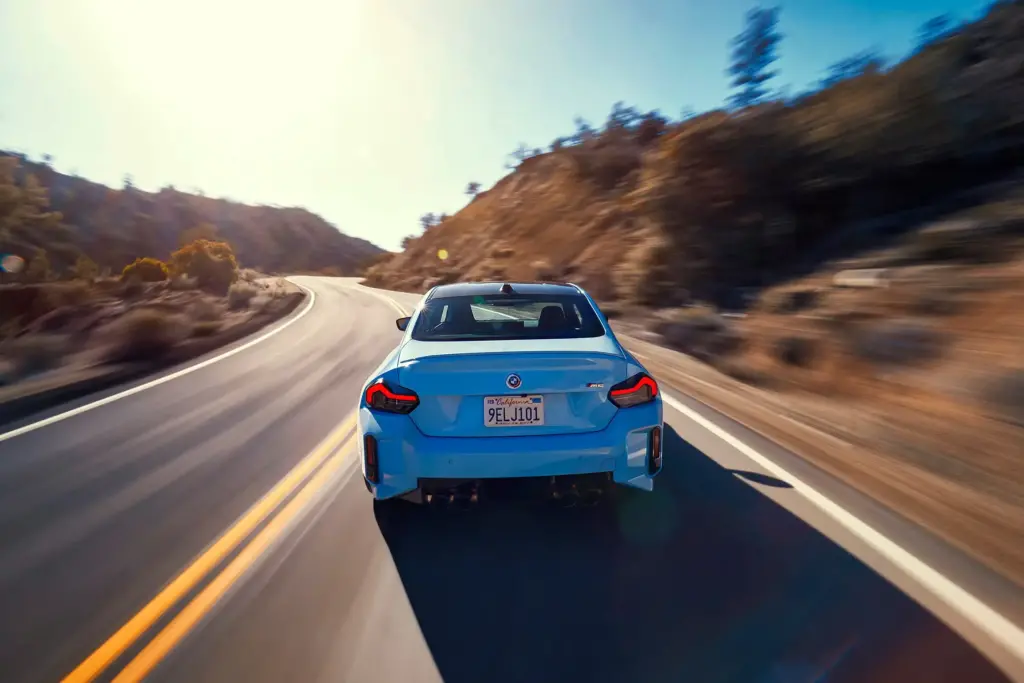
2024 BMW M2 Design and Styling
Exterior Design Philosophy
The G87 M2’s design language evolved from F87 predecessor while adopting broader M3/M4 platform proportions[1][3].
Design specifications:
- Overall length: 179.4 inches (4,557 mm)
- Width: 74.3 inches (1,887 mm) including mirrors
- Height: 55.2 inches (1,403 mm)
- Wheelbase: 108.1 inches (2,747 mm)
- Track width: 62.2 inches front / 63.6 inches rear
- Design elements: Muscular flared fenders, horizontal kidney grilles, quad exhausts
- Aesthetic philosophy: “Pugnacious” and “burst-open” aggressive character[1][3]
The wide-body appearance on compact wheelbase creates dramatic presence that polarizes opinions. The flared fenders accommodate 275mm front and 285mm rear tires, visually communicating performance capability while enabling exceptional cornering grip. Compared to F87 M2’s subtler aesthetic, the G87 makes bolder statement[3].
Subjective and Polarizing Styling
Modern BMW styling philosophy generates passionate reactions across enthusiast communities[3][6].
Styling debate points:
- Divisive reception: Some enthusiasts embrace aggressive design; others find it overwrought
- Platform criticism: Based on larger M3/M4 architecture, heavier than F87 (3,800 vs 3,450 lbs)
- Proportional concerns: Wide track on compact length creates unusual visual tension
- Comparative perspective: Less controversial than G80 M3/M4’s vertical kidney grilles
- Individual preference: Subjective design appreciation varies dramatically
A Phoenix-based M2 owner reflected: “I initially hated the styling online but fell in love during test drive. In person, the aggressive stance makes sense—you understand the wide fenders exist for functional reasons, not just styling drama. Photos don’t capture the cohesive whole.”
The styling criticism focuses primarily on proportional relationships rather than specific elements. Buyers should evaluate design in person before dismissing based on online images, as dimensional relationships translate differently in three dimensions[3].
Available Exterior Colors (2024)
The 2024 model year offered limited but purposeful color palette compared to 2025’s expanded options[1].
2024 color availability:
- No-charge colors: Alpine White, Black Sapphire Metallic, Brooklyn Grey Metallic
- Metallic options (+$550): Portimao Blue Metallic, Toronto Red Metallic, Zandvoort Blue Metallic
- BMW Individual finishes (+$2,000-$5,000): Limited selection compared to 2025
- Popular choices: Portimao Blue and Toronto Red retain value best in resale market
- Color impact: Popular M-specific colors command $1,000-$2,000 premiums used
Color selection significantly influences resale value and buyer pool. Neutral shades (white, black, grey) appeal broadly but lack distinction. M-specific colors (Portimao Blue, Toronto Red) attract enthusiast buyers willing to pay premiums. Unusual Individual finishes create striking appearance but potentially limit audience[1].
Wheels, Tires, and Aerodynamics
The M2’s wheel and tire package directly contributes to performance capability and visual presence[1].
| Component | Specification | Notes |
|---|---|---|
| Wheels | 19×9.0″ front / 19×10.0″ rear | M light alloy standard |
| Tires | 275/35R19 front / 285/30R19 rear | Michelin Pilot Sport 4S typical |
| Tire type | Performance summer | No all-season alternative |
| Optional brakes | M carbon ceramic (+$8,500) | Fade-resistant track use |
| Aerodynamics | Functional elements | Subtle front splitter, rear diffuser |
The staggered wheel setup prioritizes rear traction for rear-wheel-drive power delivery. Wide performance summer tires provide exceptional grip but create noticeable road noise at highway speeds. Buyers in snow-prone regions require seasonal wheel/tire swaps or alternative winter transportation[1].
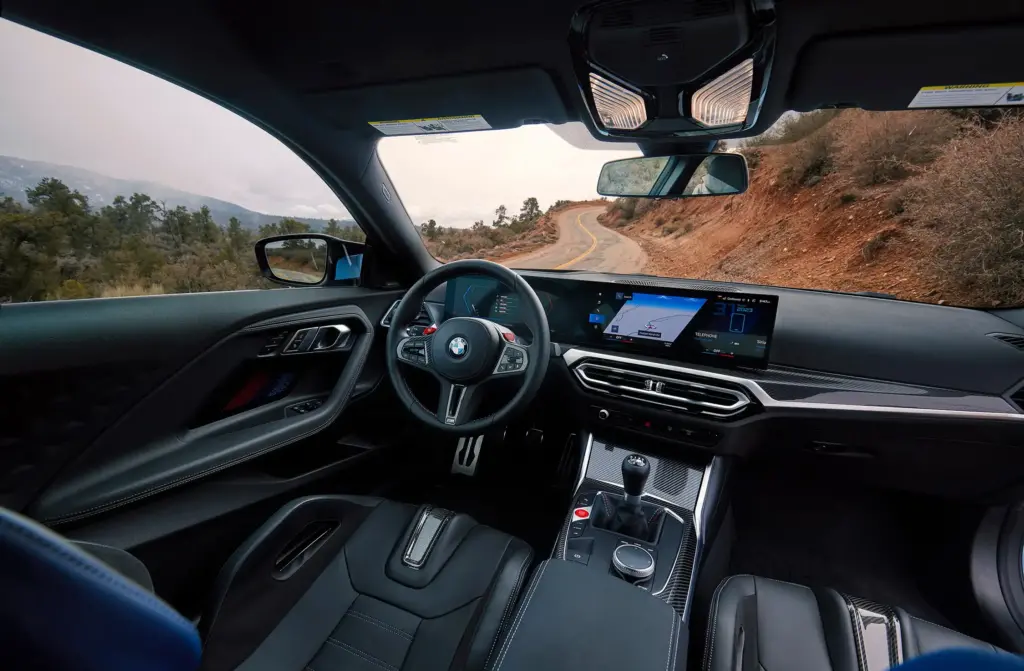
2024 BMW M2 Interior and Comfort
Cabin Design and Materials
The M2 interior emphasizes driver focus while maintaining premium material quality expected in $64,000 sports coupe[1][3].
Interior highlights:
- Material quality: Premium leather upholstery, soft-touch surfaces, brushed aluminum
- M Sport seats: Standard with power adjustment, memory, heating
- Carbon bucket seats: Optional within $9,900 Carbon Package (track-focused support)
- Steering wheel: Flat-bottom design with M badging and perforated leather
- Build quality: Solid construction with consistent panel gaps and tight tolerances
- Driver orientation: Controls and displays angled toward driver position[1][3]
The high-quality interior with comfortable leather seats and quality craftsmanship earns consistent reviewer praise. Materials meet premium expectations, though the M2 prioritizes performance focus over luxury opulence found in luxury BMW models like the i7[3].
Space and Practicality Limitations
Compact coupe dimensions create predictable space constraints that buyers must honestly assess[1][3].
Interior space measurements:
- Front headroom: 38.9 inches (adequate for 6’2″ drivers)
- Front legroom: 42.2 inches
- Rear headroom: 35.6 inches (tight for adults)
- Rear legroom: ~31 inches (snug quarters not accommodating for adults)
- Trunk capacity: 14-15 cubic feet (390 liters)
- Rear seats: Best suited for bags, not regular adult passengers[1]
The M2 functions best as 2+2 configuration rather than true four-seater. Rear accommodations suit children or emergency adult transport but lack comfort for extended journeys. Front cabin provides adequate space for most drivers, though taller occupants may find headroom marginal with sunroof-equipped examples[3].
Seating Position and Ergonomics
Driver interface design prioritizes performance driving position and intuitive control access[1].
Ergonomic characteristics:
- Driving position: Low, sporty with excellent pedal alignment
- Outward visibility: Good for sports coupe segment (better than Camaro/Challenger)
- Control placement: Logical layout for frequently-accessed functions
- M-specific gauges: Performance-oriented instrument cluster displays
- Storage solutions: Cup holders, door pockets, center console adequate for essentials
- Rear visibility: Limited due to coupe roofline and thick C-pillars
The flat-bottom steering wheel provides thigh clearance during aggressive driving while maintaining comfortable highway cruising grip. M1 and M2 buttons on steering wheel provide instant access to driver-configured vehicle setups—transforming character with single button press[1].
Interior Color Schemes and Options
BMW offered focused interior customization emphasizing performance aesthetics over extensive choice[1].
Interior schemes available:
- Black: Standard all-black leather with contrast stitching
- Black with Red Highlight: Black base with red accent stitching and trim
- Black with M Color Highlight: Black base with blue/purple/red M tricolor striping
- Alcantara: Steering wheel and shift boot material providing grip
- Carbon fiber trim: Interior package adding visual drama within Carbon Package
The limited palette reflects M car philosophy prioritizing function over fashion. While buyers seeking extensive personalization may find options restrictive compared to luxury competitors, this focused approach reduces decision complexity[1].
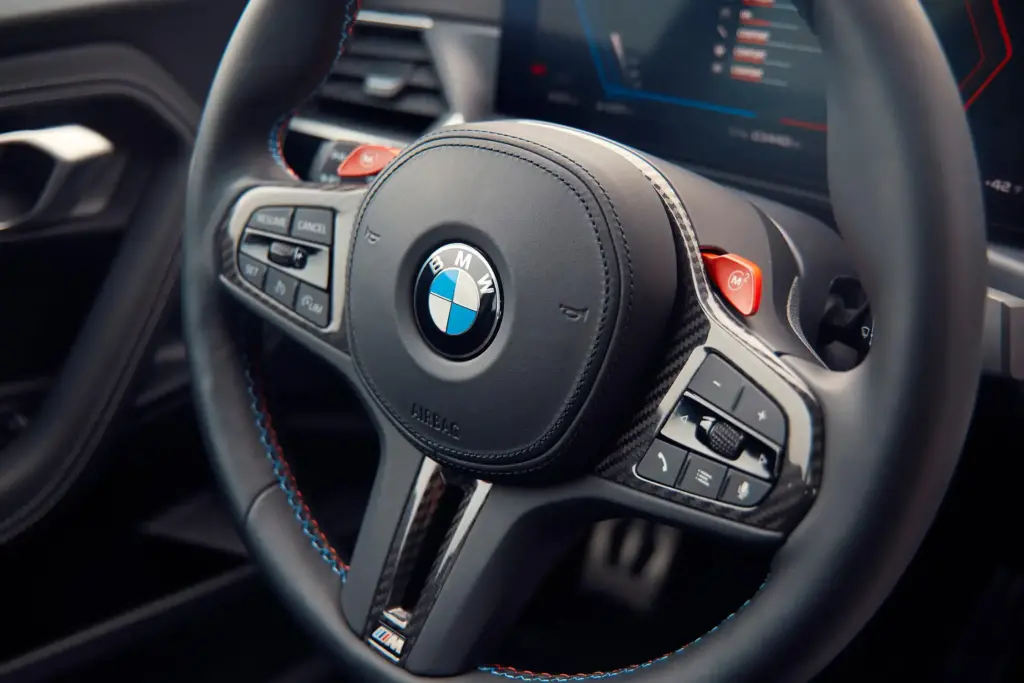
2024 BMW M2 Technology and Features
iDrive 8 Infotainment System
The 2024 M2 features iDrive 8 operating system, predating the 2025’s improved iDrive 8.5 iteration[1][4].
Technology specifications:
- Instrument cluster: 12.3-inch fully digital driver display
- Touchscreen: 14.9-inch curved OLED display with haptic feedback
- Operating system: iDrive 8 (not updated 8.5 version in 2025)
- Wireless connectivity: Apple CarPlay and Android Auto without cables
- Voice control: BMW Intelligent Personal Assistant with natural language
- Navigation: Real-time traffic integration with cloud-based routing
- Updates: Over-the-air software updates adding features post-purchase[1]
The iDrive 8 system represents substantial improvement over iDrive 7, particularly in processing speed and graphics quality. However, the system receives mixed reviews regarding usability compared to previous generations with more physical controls[1][4].
Infotainment Usability Concerns
Heavy touchscreen reliance creates legitimate frustration for some drivers[1][3].
Common usability criticisms:
- Touchscreen dependency: Most car settings require touchscreen navigation versus physical buttons
- Climate control: Accessing temperature adjustments through touchscreen described as “user-experience nightmare”
- Physical control elimination: Previous generation offered more dedicated buttons and dials
- Voice control limitations: Helps but not always reliable, especially with ambient noise
- Menu navigation: Learning curve required to locate functions efficiently
- Driving distraction: Adjusting settings while driving requires more attention than physical controls[1][3]
A Seattle-based M2 owner commented: “After three months, I’ve adapted to touchscreen controls, but I still miss the iDrive 7 controller knob from my previous BMW. Simple functions like adjusting volume or changing drive modes required less attention away from the road.”
Voice control partially addresses concerns, though system recognition accuracy varies with ambient noise levels and command phrasing. Most owners adapt within several weeks, though preference for older physical control schemes persists[3].
Driver Assistance and Safety Technology
Modern safety systems balance driver engagement priorities with accident prevention capability[1].
Standard and optional safety features:
- Active Driving Assistant: Lane departure warning, frontal collision warning with braking
- Adaptive cruise control: Stop-and-go capability in traffic (optional)
- Lane keeping assist: Active steering intervention maintaining lane position
- Blind spot monitoring: Visual and haptic warnings for adjacent vehicles
- Parking sensors: Front and rear obstacle detection
- Rearview camera: Standard rear visibility enhancement
- Head-up display: Projects information on windshield (optional)
- 360-degree camera: Bird’s-eye parking view (optional)[1]
NHTSA and IIHS have not yet crash-tested the 2024 M2 specifically, though the shared platform with M3/M4 suggests strong structural safety. The comprehensive airbag system and rigid body structure provide occupant protection meeting federal safety standards[1].
Audio and Convenience Features
Luxury amenities enhance daily usability without compromising performance character[1].
Convenience equipment:
- Harman Kardon audio: 12-speaker premium sound system (standard on 2024)
- Comfort Access: Keyless entry and push-button start (optional)
- Remote engine start: Pre-condition cabin temperature before entry
- Heated elements: Front seats and steering wheel (optional)
- Wireless charging: Inductive phone charging pad in center console
- Ambient lighting: Customizable LED cabin illumination with multiple themes
The standard Harman Kardon audio system provides excellent sound quality for most listeners, representing value-add equipment included at no additional cost on 2024 models[1].
M-Specific Performance Technology
BMW M division technology enables precise vehicle control and performance optimization[1].
M performance systems:
- M Drive modes: Configurable settings for engine, transmission, suspension, steering
- M buttons (M1, M2): Steering wheel shortcuts to saved configurations
- Launch control: Optimized start procedure for maximum acceleration
- Active M Differential: Electronic limited-slip rear differential
- M Dynamic Mode (MDM): Intermediate stability control allowing controlled slides
- Performance data recorder: Optional lap timer and telemetry logging
The M1 and M2 buttons revolutionize drive mode accessibility, enabling instant vehicle character transformation without menu navigation. Single button press recalls complete setup encompassing all adjustable parameters[1].
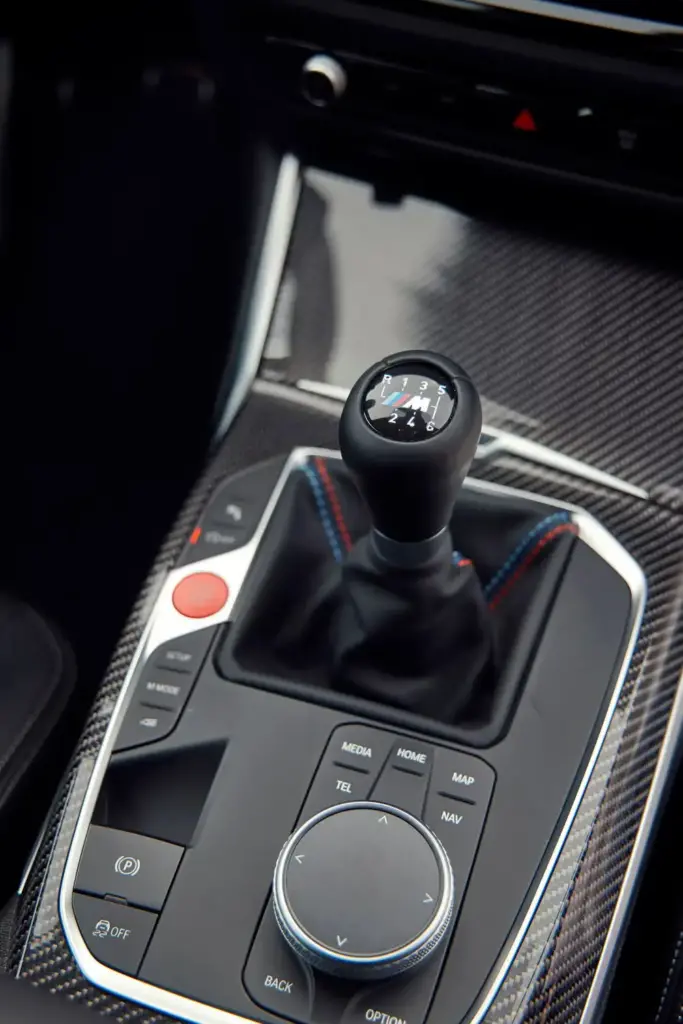
2024 BMW M2 Trim Levels and Packages
Standard M2 Equipment
The 2024 M2 included comprehensive standard equipment justifying its $64,195 starting price[1].
Standard equipment:
- Powertrain: 453 hp S58 twin-turbo engine, choice of manual or automatic (no-cost)
- Wheels: 19-inch M light alloy with Michelin Pilot Sport 4S tires
- Seats: M Sport seats with power adjustment and memory
- Technology: iDrive 8, 14.9-inch touchscreen, wireless smartphone integration
- Audio: Harman Kardon surround sound system (12 speakers)
- Lighting: LED headlights and taillights with signature BMW design
- Braking: M Sport brakes with blue-painted calipers
- Differential: Active M limited-slip rear differential[1]
Unlike some competitors requiring expensive packages for basic performance hardware, BMW included core M technologies standard. The Active M Differential, adaptive suspension, and Harman Kardon audio came with every 2024 M2[1].
Carbon Package ($9,900)
The Carbon Package represented best-value performance upgrade, bundling weight-saving components with M Driver’s Package[1].
Carbon Package contents:
- Carbon fiber roof: Lightweight panel reducing weight and lowering center of gravity
- M Carbon bucket seats: Lightweight fixed-back performance seats with aggressive bolstering
- Carbon fiber interior trim: Dashboard and door panel accent pieces
- M Driver’s Package: Raised 177 mph top speed limiter (included value $2,500)
- Weight savings: Approximately 40-50 lbs total reduction
- Value proposition: Package pricing $9,900 for components worth $13,000+ individually[1]
Used 2024 M2s equipped with Carbon Package typically command $3,000-$5,000 premiums versus base examples, representing partial recovery of original option cost. Buyers prioritizing track use should seek Carbon Package-equipped examples[1].
Additional Option Packages
Supplementary packages addressed specific buyer priorities beyond core performance[1].
Available option packages:
- M Driver’s Package ($2,500 standalone): Raised 177 mph top speed, BMW Performance Center instruction
- Lighting Package ($650): Adaptive LED headlights with automatic high beams
- Executive Package: Harman Kardon audio (standard on 2024), Comfort Access, heated seats
- BMW Individual colors: Premium paint finishes adding $2,000-$5,000
- M carbon ceramic brakes ($8,500): Fade-resistant braking for extensive track use
The M carbon ceramic brakes deserve careful consideration. While providing fade-resistant performance and reducing unsprung weight, replacement costs reach $12,000-$15,000 for complete rotor and pad service—exceeding the original option price[1].
Build and Price Considerations for Used 2024 Models
Used 2024 M2 pricing varies based on mileage, condition, options, and geographic location[1][2].
Used pricing tiers (September 2025):
- Base models (10,000-15,000 miles): $47,000-$52,000
- Well-equipped (Carbon Package, low miles): $54,000-$60,000
- Exceptional examples (sub-5,000 miles, loaded): $60,000-$62,000
- Manual transmission premium: $1,000-$2,000 over automatic equivalents
- CPO examples: Add $2,000-$3,000 for certified warranty extension
Buyers should target low-mileage examples under 15,000 miles retaining significant factory warranty coverage. Understanding the car purchase timeline helps navigate used M2 acquisition efficiently[1].
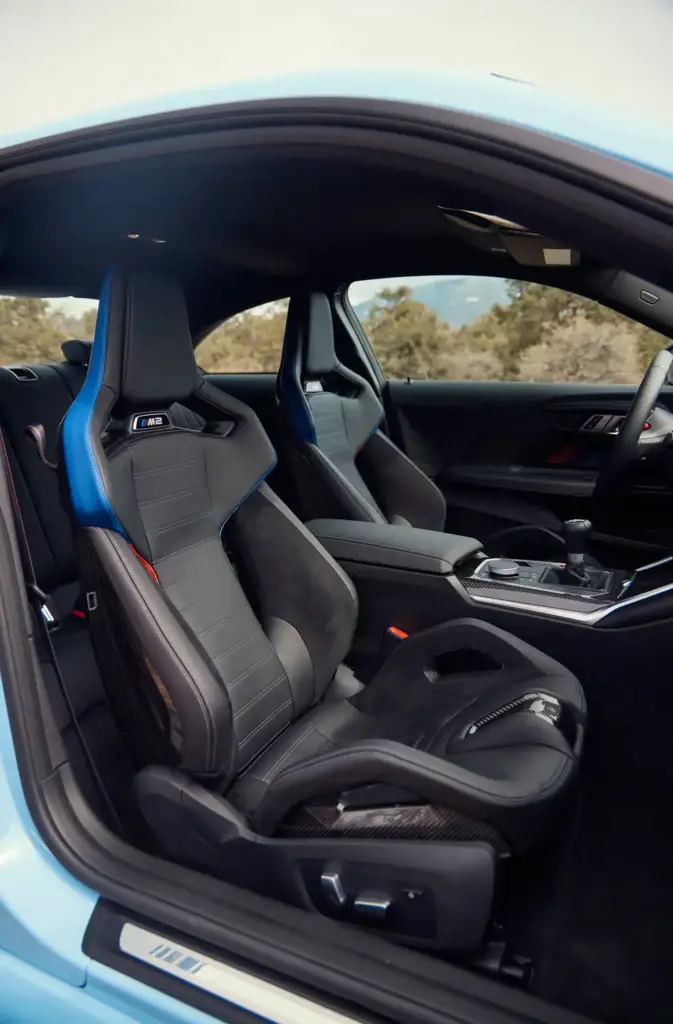
2024 BMW M2 Pricing and Value
Original 2024 MSRP and Current Used Pricing
The pricing evolution from new to used reveals substantial depreciation creating value opportunity[1][2].
| Pricing Category | Amount | Notes |
|---|---|---|
| Original base MSRP | $63,200 | Manufacturer suggested retail |
| Destination charge | +$995 | Total $64,195 |
| Average paid new | $64,670 | Including minor options |
| New 2024 clearance | $59,000-$62,000 | Remaining dealer inventory |
| Used pricing (Sep 2025) | $47,000-$56,000 | Typical range |
| 1-year depreciation | -$17,000-$19,000 | 27-30% loss |
| Trade-in values | $50,000-$56,000 | Dealer wholesale offers |
The substantial first-year depreciation creates compelling opportunity for value-conscious buyers willing to accept previous-year model. Used examples cost less than new 2025 base price ($66,675) while delivering 95% of performance and capability[1][2].
Depreciation Analysis
Long-term value retention follows predictable patterns for performance BMWs[2][7].
Projected depreciation schedule (2024 M2, $66,675 new price):
- Year 1 (2025): 27% depreciation, $48,926 value (-$17,749)
- Year 2 (2026): 30% total depreciation, $47,026 value (-$19,649 total)
- Year 3 (2027): 40% total depreciation, $40,005 value (-$26,670 total)
- Year 5 (2029): 46% total depreciation, $30,911 value (-$35,764 total)
The M2 depreciates better than average BMW models but worse than limited-production M cars. Manual transmission examples may hold value better long-term given increasing rarity, potentially offsetting 3-5% additional depreciation versus automatics[2][7].
2024 vs 2025 Value Proposition
Comparing model years reveals whether updates justify premium pricing[1][4].
Value comparison analysis:
2024 advantages
- $10,000-$15,000 lower cost (used vs new 2025)
- Proven production year without first-year issues
- Depreciation already absorbed by original owner
- Same fundamental platform and driving dynamics
- Factory warranty coverage on low-mileage examples
2025 advantages
- 20 additional horsepower (473 vs 453 hp)
- iDrive 8.5 with improved interface
- Redesigned steering wheel with red stripe
- Expanded color options (Sao Paulo Yellow, Vegas Red)
- Standalone M Carbon bucket seat option
- Reportedly refined suspension tuning
The 20-horsepower difference proves negligible in real-world driving—both achieve sub-4-second 0-60 mph times. Budget-conscious buyers prioritizing value should choose 2024; those wanting latest specifications should select 2025[4].
Cost of Ownership Analysis
Total ownership costs extend beyond purchase price into ongoing expenses[1][7].
Annual ownership cost estimates (15,000 miles):
| Expense Category | Annual Cost | 5-Year Total |
|---|---|---|
| Insurance | $2,500-$4,000 | $12,500-$20,000 |
| Maintenance | $1,500-$2,500 | $7,500-$12,500 |
| Fuel (premium) | $2,900-$3,200 | $14,500-$16,000 |
| Registration/taxes | $800-$2,000 | $4,000-$10,000 |
| Depreciation | $6,000-$8,000 | $30,000-$40,000 |
| Total annual | $13,700-$19,700 | $68,500-$98,500 |
Kelley Blue Book estimates 5-year cost to own at $101,709 for new purchase, including depreciation, fuel, insurance, and maintenance. Buying used eliminates steepest depreciation period, substantially reducing total ownership cost[7].
Financing and Lease Considerations (Used)
Financial structuring impacts monthly payments and total cost[1].
Used financing estimates (September 2025, excellent credit):
- Used car loan rates: 6.5%-9.5% depending on credit score and loan term
- CPO financing rates: 5.5%-7.5% (better rates for certified vehicles)
- 48-month loan ($10,000 down, $52,000 financed @ 7.5%): ~$1,250/month
- 60-month loan ($10,000 down, $52,000 financed @ 7.5%): ~$1,040/month
- Total interest paid: $8,000-$12,000 over loan term
Buying used avoids steepest depreciation period while potentially securing favorable CPO financing rates. Cash purchase eliminates interest expenses but ties up capital that could generate investment returns[1].
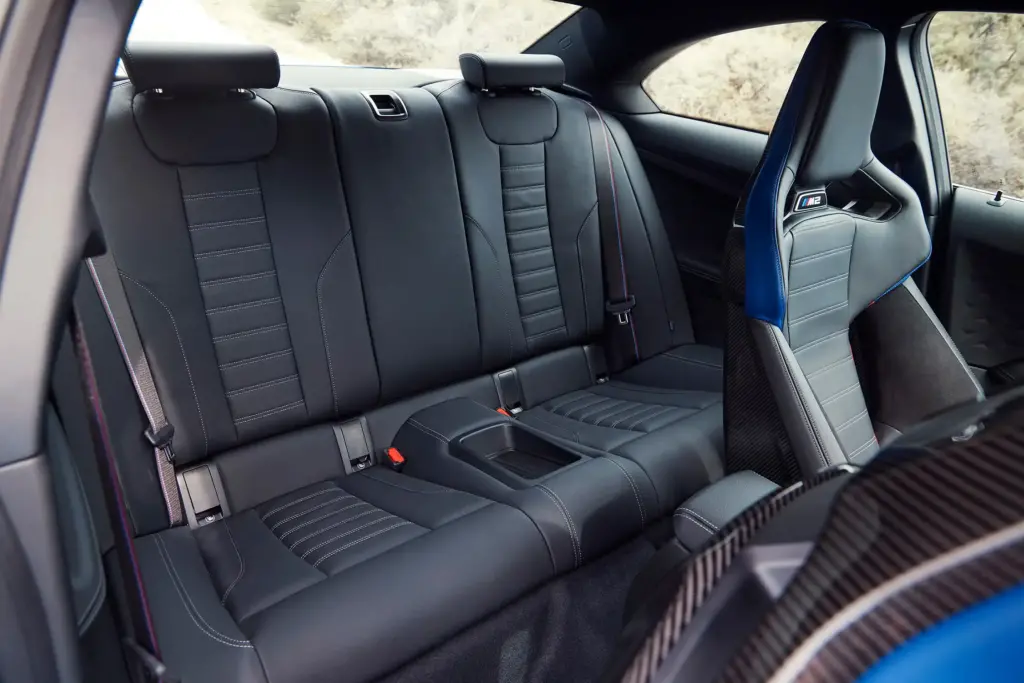
2024 BMW M2 vs. Key Competitors
2024 BMW M2 vs. 2024 BMW M4
The intra-brand comparison helps buyers determine appropriate M car sizing[1].
| Specification | M2 | M4 Competition |
|---|---|---|
| Power | 453 hp | 503 hp |
| 0-60 mph | 3.9 sec | 3.4 sec |
| Original MSRP | $64,195 | $87,000+ |
| Used pricing (2024) | $47K-$56K | $65K-$75K |
| Wheelbase | 108.1″ | 112.8″ |
| Weight | ~3,800 lbs | ~4,000 lbs |
| Manual option | Yes | No (US market) |
The M2 represents “right-sizing” for buyers prioritizing agility over outright power. The $23,000 original price difference ($20,000+ difference used) favors M2 for value-focused buyers. Both share S58 engine architecture with M4 producing 50 additional horsepower[1].
2024 BMW M2 vs. Porsche 718 Cayman
This cross-brand rivalry represents front-engine versus mid-engine layout philosophy[1].
Performance comparison:
- M2: 453 hp, $64,195 new / $47K-$56K used, front-engine RWD, rear seats
- Cayman base: 300 hp, $72,800 new, mid-engine RWD, two-seater only
- Cayman GTS: 400 hp, $90,300 new, enhanced mid-engine handling
- M2 advantage: 153 hp more than base Cayman, costs less, rear seats add practicality
- Cayman advantage: Mid-engine layout provides superior weight distribution (45/55), better steering feedback
The base Cayman costs $8,605 more than M2 originally while delivering 153 fewer horsepower—positioning strongly favoring BMW. Used Caymans hold value better than M2s, narrowing pricing gap in secondary market[1].
2024 BMW M2 vs. Toyota GR Supra
Platform-sharing creates interesting comparison between German and Japanese sports coupes[1].
Shared DNA analysis:
- Platform commonality: Both use BMW CLAR architecture
- Engine relationship: Related BMW inline-six engines (B58 in Supra, S58 in M2)
- M2 advantages: 71 additional hp (453 vs 382), manual transmission option, rear seats
- Supra advantages: $8,000-$10,000 lower original pricing, Toyota reliability reputation, slightly lighter
- Performance: M2 quicker acceleration, Supra adequate for most buyers
The Supra delivers approximately 85% of M2 performance for 12-15% less money while providing Toyota’s legendary reliability. Both share BMW engineering, though M2 receives more performance-focused tuning throughout[1].
2024 BMW M2 vs. Chevrolet Corvette C8
American versus German performance philosophies clash at similar price points[1].
Corvette comparison:
- Price parity: Both originally started around $64,000-$68,000
- M2 character: Front-engine, practical daily driver, rear seats, trunk space
- Corvette character: Mid-engine, exotic presence, 495 hp, minimal storage
- Attention factor: Corvette draws significantly more public attention
- Daily usability: M2 superior for commuting and errands
- Track capability: Both excellent despite different approaches
The Corvette’s mid-engine layout and dramatic styling create supercar experience at mainstream pricing. The M2 prioritizes daily usability while delivering weekend performance. Neither choice proves wrong—individual priorities determine best fit[1].
2024 BMW M2 vs. Audi RS 3
Rear-drive coupe confronts all-wheel-drive sedan in performance compact comparison[1].
RS 3 matchup:
- M2: RWD coupe, 453 hp, manual option, two-door configuration
- RS 3: AWD sedan, 401 hp, automatic-only, four-door practicality
- M2 engagement: RWD dynamics, manual transmission, pure driving focus
- RS 3 versatility: AWD all-weather capability, sedan utility, broader usability
- Pricing: Similar mid-$60K original range, comparable used values
The RS 3 provides all-weather capability and sedan practicality but lacks manual transmission and RWD driving character. Buyers prioritizing year-round utility choose RS 3; those wanting maximum engagement select M2[1].
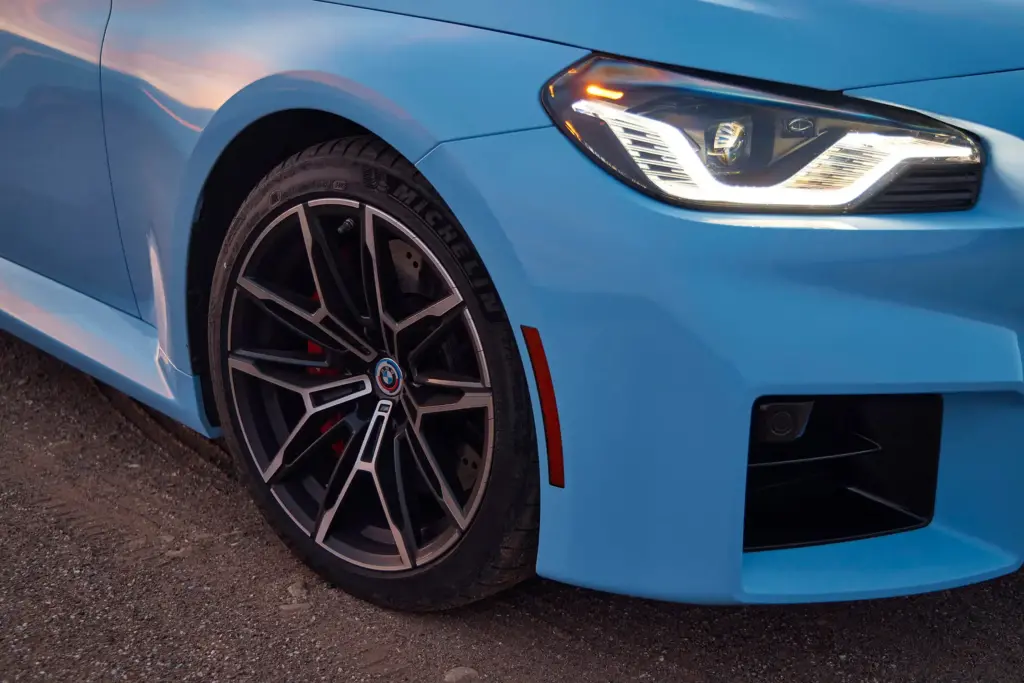
2024 BMW M2 Reliability and Common Issues
Known Reliability Concerns
The G87 M2 exhibits specific reliability issues buyers should inspect before purchase[8].
Common problems reported:
- Rear taillights: Indicator and turn signal failures requiring replacement (most frequent issue)
- Oil leaks: Valve cover gasket and oil pan gasket deterioration
- Valvetronic system: Eccentric shaft sensor/motor failures causing misfires
- Indicator malfunctions: Rapid blinking, warning lights, intermittent operation
- Engine misfires: Often related to Valvetronic system issues
- Overall reliability: Better than older M cars, improved from N54/N55/S55 predecessors[8]
A Dallas-based M2 owner reported: “At 12,000 miles, my rear driver’s side taillight failed completely—no turn signal or brake light. Dealer replaced entire assembly under warranty within two days. Common issue BMW acknowledges.”
These issues typically covered under factory warranty for low-mileage examples. Buyers should inspect taillights operation, check for oil leaks underneath, and request maintenance records documenting any previous repairs[8].
Engine-Specific Issues
The S58 engine shows strong reliability with proper maintenance but exhibits specific wear patterns[8].
S58 concerns:
- General reliability: Strong track record with proper care, significantly better than predecessors
- Oil pan gasket: Prone to leaks over time, especially after 30,000+ miles
- Valve cover gasket: Deterioration causes oil seepage onto exhaust components
- Oil leak symptoms: Engine smoke on startup, dark puddles underneath, low oil warnings
- Maintenance critical: Regular oil changes every 10,000 miles prevent premature wear
- Turbocharger durability: Twin-scroll turbos generally reliable when oil maintained[8]
The S58’s closed-deck design and forged internals provide structural strength preventing head gasket failures plaguing earlier open-deck BMW turbo engines. Proper warm-up procedures and avoiding extended high-load operation before oil reaches operating temperature extend longevity[8].
Maintenance Requirements and Costs
High-performance engines demand more frequent and expensive service than economy vehicles[1].
Maintenance schedule and costs:
- Oil changes: Every 10,000 miles or annually, $150-$250 (synthetic oil requirement)
- Brake fluid: Every 2 years regardless of mileage, $150-$200
- Coolant replacement: Every 4 years or 50,000 miles, $200-$300
- Spark plugs: Every 60,000 miles, $400-$600 (six-cylinder complexity)
- Differential fluid: Every 50,000 miles, $200-$300
- Transmission fluid: Every 60,000 miles, $300-$400
- Annual maintenance average: $1,500-$2,500 for normal driving[1]
Track use accelerates wear on brake pads, tires, and fluids, potentially doubling maintenance expenses. Carbon ceramic brake replacement costs $12,000-$15,000 for complete rotor and pad service—exceeding original option price[1].
Warranty Coverage
Understanding warranty terms helps buyers assess risk and protection[1].
Warranty details:
- Basic warranty: 4 years / 50,000 miles (bumper-to-bumper coverage)
- Powertrain warranty: 4 years / 50,000 miles (engine, transmission, drivetrain)
- Corrosion warranty: 12 years / unlimited miles (perforation only)
- Roadside assistance: 4 years / unlimited miles
- CPO extension: Adds 1 year / unlimited miles to existing coverage
- Transferability: Factory warranty transfers to subsequent owners[1]
Low-mileage 2024 examples retain substantial warranty coverage. A 2024 M2 with 8,000 miles purchased in September 2025 maintains approximately 3 years / 42,000 miles remaining warranty—significant protection against unexpected repairs[1].
Long-Term Ownership Considerations
Five-year ownership reveals costs beyond regular maintenance[1].
Long-term factors:
- Suspension wear: Control arm bushings, end links require replacement 60,000-80,000 miles
- Brake system: Standard steel rotors last 30,000-50,000 miles, pads 20,000-40,000 miles
- Carbon ceramic brakes: Last 80,000+ miles but replacement costs $12,000-$15,000
- Cooling system: Water pump, thermostat typically need replacement 80,000-100,000 miles
- Premium fuel requirement: Ongoing $2,900-$3,200 annual expense
- Parts availability: Generally good for current-generation models
Manual transmission M2s may command resale premiums as manual M cars become extinct. The 2026 BMW M2 CS introduces automatic-only variant, potentially making manual base M2s increasingly collectible[1].
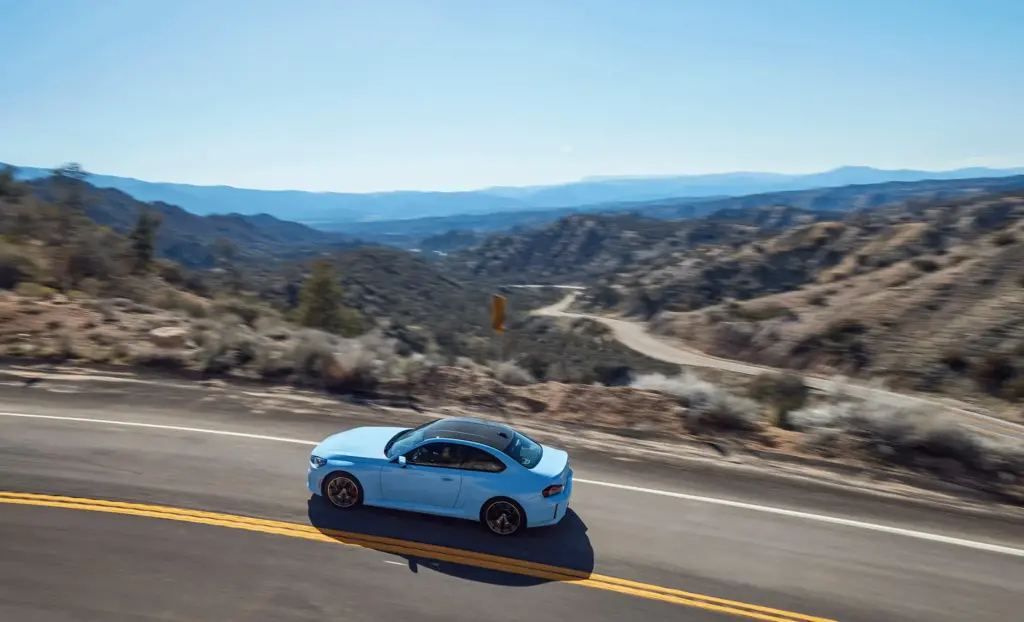
Should You Buy a 2024 BMW M2?
Who Should Buy the 2024 M2
Specific buyer profiles benefit most from 2024 used purchase[1].
Ideal 2024 buyers:
- Value seekers: Prioritizing $10,000-$15,000 savings versus new 2025
- Manual enthusiasts: Wanting three-pedal M car before option disappears
- Weekend performers: Track day participants needing street-legal performance
- Driving engagement priority: Those valuing involvement over luxury comfort
- Budget-conscious: Avoiding premium pricing of newer model years
- Smart shoppers: Recognizing proven production year without first-year issues
A Miami-based buyer shared: “I considered waiting for 2025 but realized the 20 hp difference wouldn’t change my driving experience. Saved $13,000 buying lightly-used 2024 with 7,500 miles—money I invested in track day instruction instead.”
Who Should Consider the 2025 Instead
Certain priorities justify new 2025 purchase despite premium pricing[4].
Better 2025 candidates:
- Latest technology: Prioritizing iDrive 8.5 and updated features
- Maximum power: Wanting every available horsepower (473 vs 453)
- New model year: Preferring latest year designation
- Color options: Desiring 2025-exclusive Sao Paulo Yellow, Vegas Red
- Standalone options: Wanting M Carbon bucket seats without full Carbon Package
- Premium indifferent: Not concerned about $10,000-$15,000 additional cost
The 2025 improvements prove incremental rather than transformational. Buyers for whom budget represents no constraint should purchase new 2025; those prioritizing value should target well-maintained 2024 examples[4].
Who Should Look at Alternatives
The M2 doesn’t suit all buyers despite exceptional performance[1].
Consider alternatives if:
- Space requirements: Needing comfortable adult rear passenger accommodation regularly
- Ride comfort priority: Sensitive to firm suspension and road noise
- Fuel economy concerns: Daily long-distance commuting where efficiency matters
- Steering feedback: Desiring hydraulic steering communication versus electric assist
- Styling preferences: Finding M2’s aggressive appearance too polarizing
- All-weather needs: Requiring AWD capability for winter driving
Buyers prioritizing ride comfort for daily commuting should honestly assess whether M2’s firm suspension suits tolerance. Even Comfort mode transmits more harshness than luxury sedans, representing intentional trade-off for handling precision[1].
Best Time to Buy a Used 2024 M2
Strategic timing maximizes negotiation leverage and selection[1].
Optimal buying windows:
- Current market (September 2025): Good availability, moderate pricing, warranty coverage remaining
- Winter months (November-February): Better deals as sports car demand drops seasonally
- End of calendar year (December): Dealers motivated to clear inventory before year-end
- Early 2026: Additional depreciation on 2024s as they age further
- CPO priority: Certified Pre-Owned extends warranty, provides peace of mind
- Low-mileage targets: Examples under 15,000 miles retain most warranty coverage
- Manual urgency: Three-pedal models selling faster given increasing rarity
Seasonal demand fluctuations create opportunity. Sports coupe demand peaks spring/summer, drops winter. Patient buyers willing to purchase during slower months negotiate better pricing[1].
Buying Tips and Negotiation Strategies
Strategic approach maximizes value during used M2 acquisition[1].
Buying strategies:
- Research values: Consult Kelley Blue Book ($51,700-$53,300), Edmunds ($51,700-$59,000), CarGurus
- Target pricing: Dealer asking $52,000-$58,000 range typical
- Trade-in knowledge: $50,000-$56,000 wholesale values inform negotiation floor
- Known issues inspection: Check taillights, oil leaks, indicators, maintenance records
- CarFax/AutoCheck: Verify accident history, ownership, service records
- CPO consideration: $2,000-$3,000 premium extends warranty, provides confidence
- Test drive thoroughness: Various road surfaces assess ride quality tolerance
- Pre-purchase inspection: Independent BMW specialist inspection recommended ($150-$250)
A Boston-based buyer negotiated $54,900 purchase on $57,500 asking price by presenting competing dealer quotes and highlighting known taillight issue requiring attention. Understanding market values creates negotiation leverage[1].
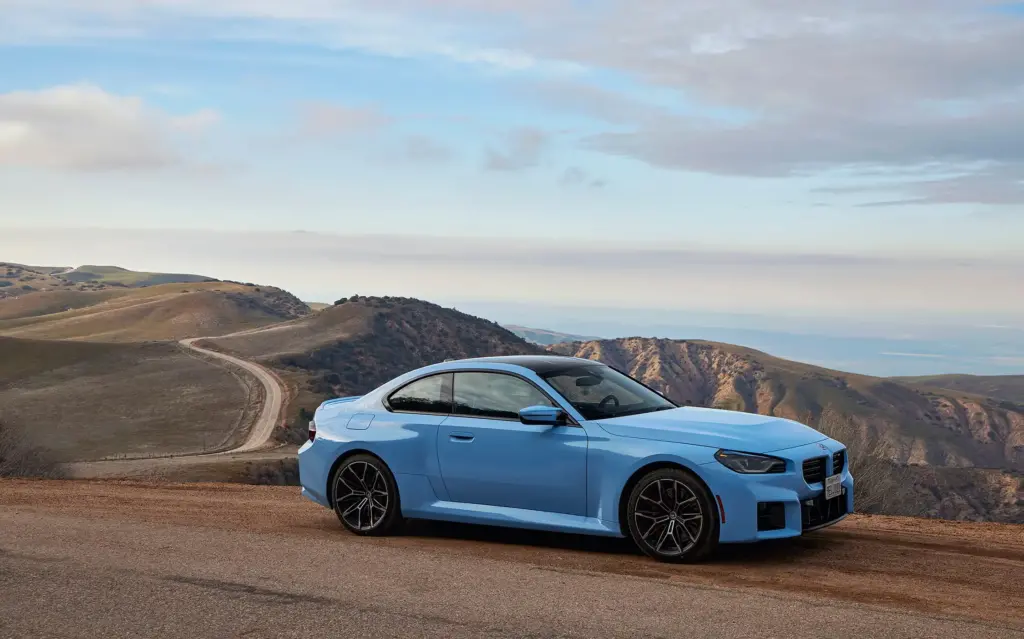
Key Takeaways
- The 2024 M2 costs $47,000-$56,000 used (Sep 2025), saving $10,000-$15,000 versus new 2025 models with minimal performance difference.
- Common issues include rear taillight failures and oil leaks; inspect these before purchase and verify maintenance records.
- The 453 hp S58 engine delivers weapons-grade performance with 3.9-second 0-60 mph; 20 hp less than 2025 proves negligible.
- Manual transmission availability makes 2024 M2 potentially last three-pedal BMW M car; choose manual for collector value.
- Firm ride quality and 19 mpg combined fuel economy affect daily usability; test drive thoroughly before committing.
- Target low-mileage examples under 15,000 miles to maximize remaining factory warranty coverage (4 years/50,000 miles total).
- CPO examples add 1 year/unlimited miles warranty for $2,000-$3,000 premium; worth considering for peace of mind.
FAQs
Is the 2024 BMW M2 reliable?
The S58 engine shows strong reliability with proper maintenance, significantly better than previous BMW M engines. Common issues include rear taillight failures, oil leaks from valve cover/pan gaskets, and occasional Valvetronic system faults. Annual maintenance costs average $1,500-$2,500[8].
What’s the difference between 2024 and 2025 BMW M2?
The 2025 model adds 20 horsepower (473 vs 453), upgraded iDrive 8.5 system, redesigned steering wheel with red stripe, expanded color options, and standalone M Carbon bucket seat availability. Performance difference proves minimal in real-world driving[4].
How much is a used 2024 BMW M2 worth now?
Is the 2024 BMW M2 good for daily driving?
Yes, with caveats. The M2 provides reasonable daily usability in Comfort mode with adequate trunk space and refined interior. However, firm ride quality transmits road imperfections, rear seats suit children only, and 19 mpg combined fuel economy requires frequent gas station visits[1].
What are common problems with the 2024 BMW M2?
Most frequent issues include rear taillight/indicator failures (most common), oil leaks from valve cover and oil pan gaskets, Valvetronic system faults causing misfires, and rapid indicator blinking. These typically covered under factory warranty on low-mileage examples[8].
Does the 2024 BMW M2 have rear seats?
Yes, the M2 includes rear seats with approximately 31 inches legroom. However, space proves snug and best suited for children or occasional adult use rather than regular rear passenger transport. The M2 functions better as 2+2 configuration than true four-seater[1].
Is the 2024 M2 better than the 2025 model?
Not objectively “better,” but potentially better value. The 2024 costs $10,000-$15,000 less used while delivering 95% of 2025’s capability. The 2025’s 20 additional horsepower and updated technology prove incremental improvements rather than transformational changes. Choose 2024 for value, 2025 for latest specs[4].
How much does 2024 BMW M2 maintenance cost?
Annual maintenance averages $1,500-$2,500 for normal driving. Oil changes cost $150-$250 every 10,000 miles, brake fluid $150-$200 every 2 years, spark plugs $400-$600 at 60,000 miles. Track use significantly increases costs. Carbon ceramic brake replacement reaches $12,000-$15,000[1].
Will the 2024 BMW M2 hold its value?
Should I buy a 2024 M2 with high mileage?
Exercise caution with high-mileage examples. Target under 15,000 miles to maximize remaining warranty coverage (4yr/50K miles). Inspect for known issues: taillights, oil leaks, maintenance records. High-mileage track-use examples may exhibit accelerated wear on brakes, suspension, fluids requiring expensive repairs[1][8].
References
- Car and Driver. (2023). 2024 BMW M2 Review, Pricing, and Specs. https://www.caranddriver.com/bmw/m2-2024
- CarEdge. (2024). BMW M2 Depreciation. https://caredge.com/bmw/m2/depreciation
- Autocar. (2024). BMW M2 2024 long-term test. https://www.autocar.co.uk/car-review/long-term-reviews/bmw-m2-2024-long-term-test
- CarBuzz. (2024). 5 Key Differences Between The 2024 And 2025 BMW M2. https://carbuzz.com/5-differences-2024-and-2025-bmw-m2/
- BMW Blog. (2024). 2024 BMW M2 Review. https://www.bmwblog.com/2024/06/12/2024-bmw-m2-review/
- Top Gear. (2024). BMW M2 – long-term review. https://www.topgear.com/long-term-car-reviews/bmw/m2/m2-2dr-dct/report-1
- Kelley Blue Book. (2025). 2024 BMW M2 Price, Reviews, Pictures & More. https://www.kbb.com/bmw/m2/2024/
- WhoCanFixMyCar. (2024). BMW M2 Problems: Common issues and Repair Costs. https://www.whocanfixmycar.com/advice/common-problems-with-the-bmw-m2

I am a senior automotive analyst at Autvex. Expert vehicle evaluations, in-depth reviews, and objective analysis helping readers make informed automotive decisions with years of industry experience.




